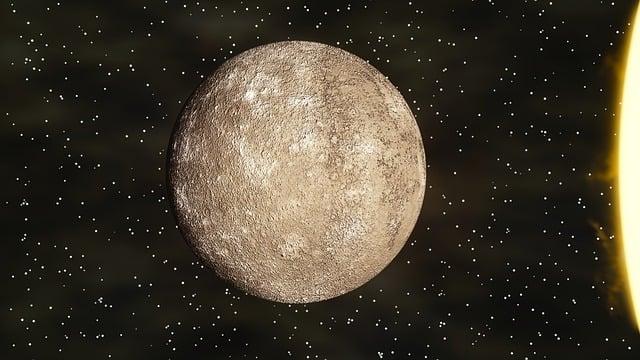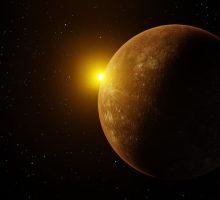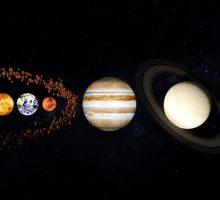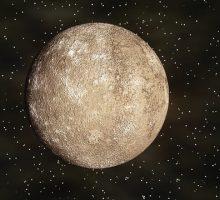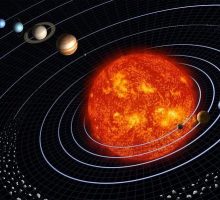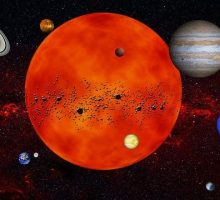- The Basics of Mercury: Characteristics, Composition, and Physical Properties
- The History of Mercury Exploration: Missions, Discoveries, and Future Plans
- The Surprising Magnetic Field of Mercury: Understanding the Planet’s Interior
- The Atmosphere of Mercury: Composition, Dynamics, and Climate
- The Enigmatic Caloris Basin on Mercury: Formation, Features, and Mysteries
- The Geology of Mercury: Tectonic Activity, Impact Craters, and Volcanic Features
- Mercury’s Orbit and Rotation: Understanding Its Unusual Characteristics
- The Search for Water on Mercury: Possibilities and Challenges
- The Connection Between Mercury and the Sun: Solar Wind, Radiation, and Effects on the Planet
- Mercury in Mythology and Culture: Tracing the Planet’s Role in Human History
The Basics of Mercury: Characteristics, Composition, and Physical Properties
Mercury, the smallest planet in our solar system, is an intriguing world that has captured the attention of scientists and space enthusiasts alike. Understanding its characteristics, composition, and physical properties can help us gain insights into the history and evolution of our solar system.
Mercury has a diameter of just 4,879 kilometers, making it only slightly larger than Earth’s Moon. It orbits the Sun at a distance of about 58 million kilometers and takes just 88 Earth days to complete one orbit. Due to its proximity to the Sun, temperatures on Mercury can reach up to 427°C during the day and drop to -173°C at night.
Mercury’s composition is primarily made up of rock and metal. Its core, which makes up about 75% of the planet’s volume, is composed mostly of iron and is believed to be responsible for the planet’s strong magnetic field. The crust is composed of various minerals, including silicates and sulfides.
The physical properties of Mercury are also noteworthy. It has a heavily cratered surface, with some of the largest impact craters being named after famous artists, writers, and musicians. The planet also has a tenuous atmosphere that is composed mostly of helium and sodium, which is thought to be generated by the solar wind interacting with the planet’s surface.
Despite its small size and proximity to the Sun, Mercury has a number of unique characteristics that make it a fascinating subject of study. By continuing to explore and learn about this planet, we can continue to expand our understanding of the solar system and the universe beyond.
The History of Mercury Exploration: Missions, Discoveries, and Future Plans
Exploring Mercury has been a long-standing goal of space scientists for decades. Although the planet is challenging to reach and study due to its proximity to the Sun and harsh environment, several missions have been launched to uncover the mysteries of this small planet. Let’s take a look at the history of Mercury exploration, the discoveries made, and future plans for further exploration.
The first mission to study Mercury was NASA’s Mariner 10, launched in 1973. This mission provided the first close-up images of the planet and discovered several surprising features, including a magnetic field and a heavily cratered surface. In 2011, NASA launched the MESSENGER spacecraft, which orbited Mercury for four years and collected data on the planet’s composition, geology, and atmosphere. MESSENGER’s findings revealed evidence of water ice in polar regions and helped scientists understand the planet’s geological history.
Currently, the European Space Agency (ESA) and the Japanese Aerospace Exploration Agency (JAXA) are jointly developing the BepiColombo mission, which launched in 2018 and is expected to arrive at Mercury in 2025. This mission includes two spacecraft that will work together to study the planet’s surface, interior, and magnetic field.
In addition to these missions, there are plans for future exploration of Mercury. NASA’s upcoming mission, the Mercury Ice and Surface Composition Explorer (MISE), is set to launch in the mid-2020s and will focus on studying the presence of water ice on the planet’s surface. Furthermore, there are plans for a joint mission between NASA and ESA to study Mercury’s magnetosphere and exosphere.
In summary, the history of Mercury exploration has been marked by groundbreaking missions and discoveries that have expanded our knowledge of the planet. With future missions and continued study, we can hope to uncover even more secrets of this small, but fascinating, world.
The Surprising Magnetic Field of Mercury: Understanding the Planet’s Interior
Mercury is the smallest planet in the solar system and one of the closest planets to the Sun. Despite its small size, Mercury has a surprisingly strong magnetic field that has puzzled scientists for years. Understanding the source and characteristics of Mercury’s magnetic field can provide insights into the planet’s interior and history.
The first evidence of Mercury’s magnetic field came from NASA’s Mariner 10 mission in 1974. The spacecraft’s flybys revealed that the planet had a weak but significant magnetic field. The discovery was surprising because Mercury was thought to have cooled down enough for its core to solidify, which would cause its magnetic field to disappear. However, the observed magnetic field indicated that the planet still had a partially molten core.
In 2011, NASA’s MESSENGER spacecraft confirmed Mariner 10’s findings and provided more detailed measurements of Mercury’s magnetic field. MESSENGER discovered that the planet’s magnetic field was offset from its center and tilted by approximately 11 degrees. These findings suggest that the planet’s magnetic field is generated by a dynamo, a process where electrically conductive material in the core creates a magnetic field.
Scientists believe that the source of Mercury’s magnetic field is its partially molten core, which is composed mostly of iron. However, the exact mechanism behind the dynamo process is still unclear. Some theories propose that Mercury’s magnetic field is generated by a combination of thermal and compositional convection in the core, while others suggest that it is driven by the interaction between the core and the planet’s mantle.
Studying Mercury’s magnetic field can provide valuable insights into the planet’s interior and history. By understanding the mechanisms that generate the magnetic field, scientists can learn more about the planet’s core, composition, and evolution. Future missions, such as the joint ESA and JAXA BepiColombo mission, will continue to explore Mercury and gather more data on its magnetic field and interior.
The Atmosphere of Mercury: Composition, Dynamics, and Climate
Mercury is known for its extreme environment, with temperatures that can reach up to 800 degrees Fahrenheit on the daytime side and drop to -290 degrees Fahrenheit on the nighttime side. Despite its close proximity to the Sun, Mercury has an atmosphere that is relatively thin compared to other planets in the solar system. In this blog, we’ll explore the composition, dynamics, and climate of Mercury’s atmosphere.
Mercury’s atmosphere is primarily composed of helium and hydrogen, with trace amounts of other gases such as oxygen, sodium, and potassium. The thin atmosphere is thought to be the result of several factors, including the planet’s small size, proximity to the Sun, and weak gravity. The solar wind also plays a role in stripping away Mercury’s atmosphere, as the planet lacks a strong magnetic field to protect it from the charged particles.
Despite its thin atmosphere, Mercury’s exosphere, the outermost layer of the atmosphere, is dynamic and exhibits complex behavior. The exosphere is continuously bombarded by particles from the solar wind, causing it to expand and contract in response. The exosphere also contains a variety of molecules, including sodium, calcium, and oxygen, which have been detected through observations and spacecraft measurements.
Mercury’s atmosphere has a significant impact on the planet’s climate, despite its thinness. The extreme temperature differences between the day and night sides of the planet result in strong winds and atmospheric circulation. The daytime side of the planet is dominated by a thin, tenuous layer of gas that is heated by the Sun, causing it to expand and rise. The gas then flows towards the nighttime side of the planet, where it cools and sinks back down to the surface.
The dynamics of Mercury’s atmosphere are still not well understood, and more research is needed to uncover the processes driving its behavior. Future missions, such as the ESA and JAXA BepiColombo mission, will continue to study Mercury and gather more data on its atmosphere and climate. Understanding the atmosphere of Mercury is crucial to understanding the planet’s evolution and can provide insights into the formation and dynamics of atmospheres in other planets in the solar system.
The Enigmatic Caloris Basin on Mercury: Formation, Features, and Mysteries
The Caloris Basin on Mercury is one of the largest impact basins in the solar system and one of the most enigmatic features on the planet. In this blog, we’ll explore the formation, features, and mysteries of the Caloris Basin.
The Caloris Basin was formed approximately 4 billion years ago when a large asteroid or comet collided with Mercury’s surface. The impact was so powerful that it created a crater more than 1,500 miles (2,400 kilometers) wide and caused seismic waves to ripple across the planet. The impact also caused the surrounding terrain to buckle and deform, creating a series of rugged mountains and ridges.
One of the most striking features of the Caloris Basin is its irregular shape. The basin is not circular like most impact craters but instead has a complex, asymmetrical shape. Scientists believe that this shape is the result of the impact occurring on a non-uniform surface, causing the shock waves to reflect and refract in different directions.
Another mystery of the Caloris Basin is the presence of unusual features within the basin, such as hollows and depressions. These features are thought to be the result of volatile substances, such as water or sulfur, evaporating from the surface after the impact. The evaporation process creates voids and pits that are then filled in with material from the surrounding area, resulting in the hollows and depressions.
Despite years of study, there are still many mysteries surrounding the Caloris Basin. For example, scientists are still unsure why the basin is located on the planet’s equator and what role it played in the planet’s geological and thermal evolution. Some theories suggest that the impact may have caused volcanic activity on the opposite side of the planet, while others propose that the basin may have influenced the planet’s magnetic field.
Studying the Caloris Basin is important for understanding the history and evolution of Mercury. Future missions, such as the ESA and JAXA BepiColombo mission, will continue to explore the planet and gather more data on the Caloris Basin and other features. As we uncover more information about Mercury’s past, we can better understand the processes that shaped the planet and the role it played in the formation and evolution of the solar system.
The Geology of Mercury: Tectonic Activity, Impact Craters, and Volcanic Features
Mercury is the smallest planet in our solar system, but it is a fascinating world with a diverse geology. In this blog, we’ll explore the tectonic activity, impact craters, and volcanic features that make up the geology of Mercury.
One of the most prominent features on Mercury’s surface is its system of tectonic faults. Unlike other planets, such as Earth, where tectonic plates move horizontally, Mercury’s faults move vertically. These faults are believed to be the result of the planet’s rapid cooling and contraction after its formation, causing the surface to crack and buckle.
In addition to tectonic activity, Mercury is also home to numerous impact craters. These craters are created when asteroids or comets collide with the planet’s surface, excavating material and leaving behind a circular depression. The size and shape of these craters can provide valuable information about the age and composition of the planet’s surface.
Mercury’s volcanic activity is another important aspect of its geology. The planet is home to numerous volcanic features, including lava plains, volcanic vents, and pyroclastic deposits. These features are believed to be the result of the planet’s early history, when it was still molten and its interior was undergoing differentiation.
One of the most interesting volcanic features on Mercury is the Caloris Montes, a range of mountains that surround the Caloris Basin. These mountains are believed to be the result of volcanic activity that occurred after the basin was formed, as magma was forced up through the surface and solidified into rock.
Studying the geology of Mercury is important for understanding the planet’s history and evolution. By examining the planet’s tectonic activity, impact craters, and volcanic features, scientists can gain insight into the processes that shaped the planet and the forces that continue to shape it today. With the help of future missions, such as the ESA and JAXA BepiColombo mission, we can continue to uncover more information about Mercury’s geology and its place in the solar system.
Mercury’s Orbit and Rotation: Understanding Its Unusual Characteristics
Mercury, the smallest planet in our solar system, has some unusual characteristics when it comes to its orbit and rotation. In this blog, we’ll explore the unique features of Mercury’s orbit and rotation and what they tell us about the planet’s history and evolution.
Mercury’s orbit around the sun is highly elliptical, with a distance ranging from 29 million miles (47 million kilometers) at its closest point to the sun, to 43 million miles (70 million kilometers) at its furthest point. This means that the planet experiences extreme temperature variations, with surface temperatures ranging from -290°F (-180°C) to 800°F (430°C).
Mercury’s orbit is also unique in that it rotates three times for every two orbits around the sun. This means that a single day on Mercury (the time it takes to complete one rotation) is actually longer than a year (the time it takes to complete one orbit). As a result, the planet experiences some interesting effects, such as the sun appearing to rise, briefly pause, and then set again before rising once more.
Another unusual characteristic of Mercury’s orbit is its perihelion precession. This means that the closest point of Mercury’s orbit to the sun slowly rotates over time, completing a full rotation every 12 years. This effect is due to the planet’s gravitational interactions with the sun and other planets in the solar system.
Mercury’s slow rotation and unusual orbit are believed to be the result of its early history. Scientists believe that the planet may have been struck by a large object early in its history, which caused it to spin slowly and altered its orbit. The planet’s proximity to the sun may have also played a role, with the sun’s intense gravity affecting Mercury’s rotation and orbit.
Studying Mercury’s orbit and rotation is important for understanding the planet’s history and evolution. By examining the planet’s unique features, scientists can gain insight into the forces that shaped the planet and its place in the solar system. With the help of future missions, such as the ESA and JAXA BepiColombo mission, we can continue to uncover more information about Mercury’s orbit and rotation, and what they can tell us about the planet’s past and future.
The Search for Water on Mercury: Possibilities and Challenges
Mercury, the closest planet to the sun, is a dry and desolate world, with no signs of liquid water on its surface. However, recent research suggests that there may be water ice hiding in the shadowed craters at the planet’s poles. In this blog, we’ll explore the possibilities and challenges of searching for water on Mercury.
One of the main challenges of searching for water on Mercury is the planet’s extreme temperatures. With surface temperatures ranging from -290°F (-180°C) to 800°F (430°C), any water on the planet’s surface would quickly evaporate or freeze. However, recent research suggests that there may be areas on the planet’s poles that are permanently shadowed and cold enough to trap water ice.
Data from NASA’s Messenger spacecraft, which orbited Mercury from 2011 to 2015, revealed that some areas near the planet’s poles have surface temperatures below -280°F (-173°C). These areas are thought to be permanently shadowed, which means that they never receive direct sunlight and may have water ice deposits.
In 2018, the European Space Agency and the Japanese Aerospace Exploration Agency launched the BepiColombo mission to Mercury, which includes a spacecraft equipped with a neutron spectrometer designed to detect water ice on the planet’s surface. The mission is expected to arrive at Mercury in 2025 and will conduct a detailed study of the planet’s surface, including its polar regions, to search for signs of water.
The search for water on Mercury is important for understanding the planet’s history and evolution. Water is a key ingredient for life, and the discovery of water ice on Mercury could have important implications for the search for life in the solar system. It could also provide valuable resources for future exploration and settlement on the planet.
The Connection Between Mercury and the Sun: Solar Wind, Radiation, and Effects on the Planet
Mercury, the smallest planet in our solar system, orbits the Sun at a distance of only about 36 million miles (58 million km). This close proximity to the Sun has a significant impact on the planet’s environment, including its atmosphere, surface, and magnetic field. In this blog, we’ll explore the connection between Mercury and the Sun, including the effects of solar wind, radiation, and other phenomena.
One of the most important ways in which the Sun affects Mercury is through solar wind. Solar wind is a stream of charged particles that flows from the Sun’s corona, or outer atmosphere, into space. Mercury’s proximity to the Sun means that it is subjected to much higher levels of solar wind than other planets in the solar system. This can have a significant impact on the planet’s atmosphere and surface.
The solar wind can strip away the planet’s tenuous atmosphere over time, as well as erode and modify its surface features. In addition, the charged particles in the solar wind can interact with Mercury’s magnetic field, creating auroras and other phenomena.
Another way in which the Sun affects Mercury is through radiation. Mercury’s proximity to the Sun means that it is exposed to high levels of ultraviolet radiation, X-rays, and other types of radiation. This can have a significant impact on the planet’s surface and atmosphere, as well as on any spacecraft or instruments that visit the planet.
Despite the challenges posed by the Sun, Mercury also has some unique characteristics that make it an important target for scientific exploration. For example, the planet’s magnetic field is much stronger than would be expected based on its size, and this has important implications for understanding the planet’s interior and evolution.
Mercury in Mythology and Culture: Tracing the Planet’s Role in Human History
Mercury, the smallest planet in our solar system, has played an important role in human culture and mythology for thousands of years. In this blog, we’ll explore the history of Mercury in mythology and culture, and how the planet has been viewed and interpreted by different civilizations throughout history.
In ancient Roman mythology, Mercury was the god of commerce, communication, and travel. He was often depicted wearing a winged helmet and sandals, which allowed him to move quickly and easily between different places. The planet Mercury was named after this Roman god, as it appears to move quickly across the sky relative to the other planets.
Mercury also played an important role in the mythology of other ancient civilizations. In Greek mythology, the planet was associated with Hermes, the messenger of the gods. In Babylonian astronomy, Mercury was known as Nabu, the god of wisdom and writing.
In addition to its role in mythology, Mercury has also been an important object of study for astronomers throughout history. Ancient astronomers, such as the Babylonians and Greeks, observed Mercury and recorded its movements across the sky. In the 17th century, Galileo Galilei was the first person to observe Mercury using a telescope, which allowed him to make detailed observations of the planet’s surface features.
Today, Mercury continues to be an important object of study for astronomers and space scientists. Several spacecraft, including NASA’s Messenger mission and the European Space Agency’s BepiColombo mission, have been sent to study the planet and its environment in detail.
In popular culture, Mercury has also made appearances in literature, music, and art. In literature, the planet has been the subject of science fiction stories and poems. In music, the British rock band Queen wrote a popular song called “Bohemian Rhapsody” that includes the line “I see a little silhouetto of a man, Scaramouche, Scaramouche, can you do the Fandango?” – a reference to the speed of Mercury’s orbit. In art, Mercury has been depicted in paintings, sculptures, and other works of art throughout history.
ScitechVenture YouTube Channel

